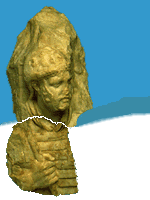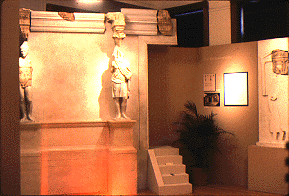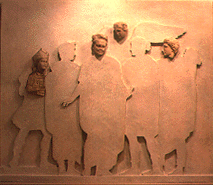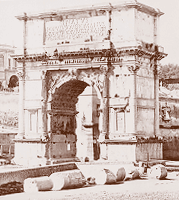

The
Templum Gentis Flaviae
 This
lost monument, formerly known only from ancient literary sources that
celebrated its size and splendor, was built by the emperor Domitian (AD
81-96) as a temple and tomb complex for members of his imperial family,
the Flavian dynasty.
This
lost monument, formerly known only from ancient literary sources that
celebrated its size and splendor, was built by the emperor Domitian (AD
81-96) as a temple and tomb complex for members of his imperial family,
the Flavian dynasty.
A synthesis of archaeological evidence and literary accounts, which record that Domitian erected the Templum Gentis Flaviae on the site of his birthplace on the Quirinal Hill, indicates that it stood near the present location of the Church of Santa Susanna, where the modern Via XX Settembre follows the course of an ancient Roman street named Alta Semita.
The Messages in Stone
The fragmentary yet elegant sculptures of the Templum Gentis Flaviae provide unprecedented insight into the decor and imagery that a first-century Roman emperor with dynastic ambitions considered appropriate for the final resting place of his imperial house. The marble decorations of the monument, however, present an idealized image of ambitions that were never fulfilled. Shortly after the Templum was completed Domitian was assassinated in AD 96, leaving no Flavian heir to the throne.
 The
sculptures of the Templum Gentis Flaviae celebrate the Flavian
dynasty, its accomplishments, and the deification of members of the Flavian
family. The Templum advertises the military successes of the Flavian
emperors, as well as their miraculous transformation into gods after death.
It also draws parallels between the great ruling dynasties of the past
and the Flavian dynasty. For example, one fragment depicts scenes
from the legendary foundation of Rome, a myth that was also illustrated
in earlier monuments of the Julio-Claudian dynasty.
The
sculptures of the Templum Gentis Flaviae celebrate the Flavian
dynasty, its accomplishments, and the deification of members of the Flavian
family. The Templum advertises the military successes of the Flavian
emperors, as well as their miraculous transformation into gods after death.
It also draws parallels between the great ruling dynasties of the past
and the Flavian dynasty. For example, one fragment depicts scenes
from the legendary foundation of Rome, a myth that was also illustrated
in earlier monuments of the Julio-Claudian dynasty.
As reconstructed here, the Pentelic marble sculptures of the Templum Gentis Flaviae are attributed to a type of altar precinct, its entablature supported by male figures (caryatids) who stand in front of palm trees, symbols of the province of Judaea where the Flavian emperors conquered rebellious Jerusalem and gained a glorious Roman triumph. Two panels of relief sculpture depict scenes drawn from Roman state religion and imperial ceremony, a sacrificial procession and a formal reception for the emperor Vespasian as he returns to Rome.
 The
three themes of visual propaganda--imperial apotheosis, equality between
emperors and deities, and military triumph over Judaea--were pioneered
in the Pentelic marble relief sculptures of the Arch
of Titus.
The
three themes of visual propaganda--imperial apotheosis, equality between
emperors and deities, and military triumph over Judaea--were pioneered
in the Pentelic marble relief sculptures of the Arch
of Titus.
Copyright ©1997, 2002 Ministero per i Beni Culturali e Ambientali, Soprintendenza Archeologica di Roma and the Kelsey Museum of Archaeology, University of Michigan. All rights reserved.
 |
 |
 |
 |
 |
 |
 |
 |
 |